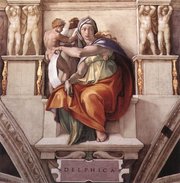The Myth of Pythia Pythia (aka Sibyl, means prophet) was the name of the Greek oracle at Delphi, a priestess of the serpent Python.

The Delphic Sibyl by Michelangelo. - A fresco at the Sistine Chapel.Pronunciation: sib'-ul
The word Sibyl comes (via Latin) from the ancient Greek word sibylla, meaning prophetess. The earlier oracular seeresses known as the sibyls of antiquity prophesied at certain holy sites, probably all of pre-Indo-European origin, under the divine influence of a deity, originally one of the chthonic earth-goddesses. Later in antiquity, sibyls wandered from place to place. Homer seems to have been unaware of a Sibyl. The first Greek writer, so far as we know, who mentions a sibyl is Heraclitus, in the 5th century BCE:
'The Sibyl, with frenzied mouth uttering things not to be laughed at, unadorned and unperfumed, yet reaches to a thousand years with her voice by aid of the god.' (Heraclitus, fragment 12)
Sibyls and their Cities in the Roman WorldSibyls are not identified by personal name, but by names that refer to the location of their temples, including one associated to an unnamed temple in Libya.
Like Heraclitus, Plato only speaks of one Sibyl, but in course of time the number increased to nine, with a tenth, the Tiburtine Sibyl, probably Etruscan in origin, added by the Romans.
According to Lactantius' Divine Institutions (i.6, 4th century AD, quoting from a lost work of Varro, 1st century BC) these ten were the Persian Sibyl, the Libyan Sibyl, the Delphic Sibyl, the Cimmerian Sibyl, the Erythraean Sibyl, the Samian Sibyl, the Cumaean Sibyl, the Hellespontine Sibyl, the Phrygian Sibyl and the Tiburtine Sibyl.
The Sibyls were also represented in publicly available art. Michelangelo fixed our image of the sibyls forever, in his powerful representations of them, seated, both aged and ageless, beyond mere femininity, in the frescos of the Sistine Chapel. The library of Pope Julius II in the Vatican has images of sibyls and they are in the pavement of the Siena Cathedral.
Late Gothic Sibyls, each with her emblem and a single line of prophecy, lettered on a fluttering banderole, were fixtures of Late Gothic illuminations, in 14th and 15th-century France and Germany[1] (http://www.lancs.ac.uk/depts/english/courses/214/sibyls/sibyls.htm).
The three most famous sibyls throughout their long career were the Delphic, the Erythraean and the Cumaean.
Long after the oracles had been silenced by the Christians in the 4th century, the number of Sibyls was increased in the Middle Ages to as many as twelve, a magical number. See, for example, the Apennine Sibyl. Ten, for François Rabelais, was the proverbial number: How know we but that she may be an eleventh Sibyl or a second Cassandra? (Gargantua and Pantagruel, iii. 16, noted in Brewer's Dictionary of Phrase and Fable, 1897 (http://www.bootlegbooks.com/Reference/PhraseAndFable/data/1137.html).
The medieval, Christianized role for the Sibyls was as precursors, prophets of the New Dispensation, Christian allies in a Hellenistic world:
Dies irae, dies illa
Solvet saeclum in favilla
Teste David cum Sibylla.
("Day of wrath, o day of mourning, when the world dissolves in the twinkling of an eye, as David foretold, and the Sibyl.")
Delphic Sibyl, the Pythia
The oracle at Delphi was commonly known as the Pythia, though her name was also Herophile. She was the Pythian priestess of Python, an archaic chthonic serpent. Later, Sibyl or Pythia became a title given to whichever priestess manned the oracle at the time. The Sibyl sat on a tripod over a cleft in the Sibylline Rock, gaining her often puzzling predictions from it. She sang her predictions, which she received from Gaia, in an ecstatic swoon; her utterings were interpreted by attendant priests during classical times, and rendered into hexameters of notoriously difficult interpretation. Pausanias claimed that the Sibyl was "born between man and goddess, daughter of sea monsters and an immortal nymph". Others said she was sister or daughter to Apollo. Still others claimed the Sibyl received her powers from Gaia originally, who passed the oracle to Themis, who passed it to Phoebe.
Pythia's breathing vapors....
Much has been made of the Pythia's breathing in vapors from the ground and eating laurel leaves. Modern reductionists dismiss the archaic propensity for visions and sometimes attempt to account for the Pythia's swoon with toxic methane or ethylene hydrocarbon vapors for example, in "Questioning the Delphic oracle," in Scientific American, October 2003. Secular mythographers doubt that the visions of Teresa of Avila would be linked in any comparable way to the effects of sacerdotal wine. As for the eating of laurel leaves, reported everywhere in modern retelling, this comes only from hostile Christian satirists, who were bent on denigrating the oracle, and is not reported in any pagan context. Before descending to the shrine, the Pythia did make a burnt offering of laurel leaves (sacred to Apollo) and barley flour (sacred to Demeter, the Earth Mother, whose presence at Delphi preceded Apollo's). The Pythia is depicted in vase-paintings holding a sprig of laurel, with a laurel-crowned interlocutor.
So, that basically gives you a background into the Pythia legend which appears to be gaining importance in Battlestar Galactica's new series.
Special thanks to: Wikipedia, the free encyclopedia for this background information.
Link To Home Page



